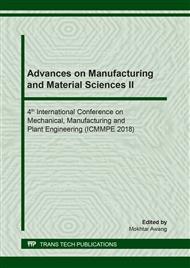[1]
WOOD E P, NIMMO K L. In search of new lead-free electronic solders [J]. Journal of Electronic Materials, 1994, 23(8): 709-713.
DOI: 10.1007/bf02651363
Google Scholar
[2]
HARRISON M R, VINCENT J H, STEEN H AH. Lead-free reflow soldering for electronics assembly [J]. Soldering & Surface Mount Technology, 2001, 13(3): 21-38.
DOI: 10.1108/09540910110407388
Google Scholar
[3]
GADAG S, PATRA S. Numerical prediction of mechanical properties of Pb-Sn solder alloys containing antimony, bismuth and or silver ternary trace elements [J]. Journal of Electronic Materials, 2000, 29(12): 1392-1397.
DOI: 10.1007/s11664-000-0124-2
Google Scholar
[4]
LEE T Y, CHOI W J, TU K N, JANG J W, KUO S M, LIN J K. Morphology, kinetics, and thermodynamics of solid-state aging of eutectic SnPb and Pb-fiee solders (Sn-3.5Ag, Sn-3.8Ag- 0.7Cu and Sn-0.7Cu) on Cu [J]. Journal of Materials Research, 2002, 17(2): 291-301.
DOI: 10.1557/jmr.2002.0042
Google Scholar
[5]
FREAR D R, JANG J W, LIN J K, ZHANG C. Pb-free solders for flip-chip interconnects [J]. Journal of Metals, 2001, 53(6): 28-32.
DOI: 10.1007/s11837-001-0099-3
Google Scholar
[6]
LEE Y G, DUH J G Interfacial morphology and concentration profile in the unleaded solder0 joint assembly [J]. Journal of Materials Science: Materials in Electronics, 2000, 11: 33-43.
Google Scholar
[7]
KARIYA Y, OTSUKA M. Mechanical fatigue characteristics of Sn-SAg-X (X= Bi, Cu, Zn, and In) solder alloys [J]. Journal of Electronic Materials, 1998, 27(11): 1229-35.
DOI: 10.1007/s11664-998-0074-7
Google Scholar
[8]
WADE N, WU K P, KLJNII J, YAMADA S, MIYAHARA K. Effect of Cu, Ag and Sb on the creep-rupture strength of lead-free solder alloys [J]. Journal of Electronic Materials, 2001, 30(9): 1228-1231.
DOI: 10.1007/s11664-001-0154-4
Google Scholar
[9]
LI C Y, CHEN B L, SHI S Q, WONG S C K, Effects of Sb addition on mechanical properties of Sn-3.5Ag-0.7Cu solder alloy and joints [J]. Thin Solid Films, 2006, 504: 421-425.
DOI: 10.1016/j.tsf.2005.09.060
Google Scholar
[10]
LI G Y, CHEN B L, TEY J N. Reaction of Sn-3.5Ag-0.7Cu-xSb solder with Cu metallization during reflow soldering [J]. IEEE Trans on EPM, 2004,27(1): 77-85.
DOI: 10.1109/tepm.2004.830507
Google Scholar
[11]
CHEN B L, LI G Y. An Investigation of effects of Sb on the intermetallic formation in Sn-3.5Ag-0.7Cu solder joints [J]. IEEE Trans on Comp & Pack Tech, 2005,28(3): 534-541.
DOI: 10.1109/tcapt.2005.848573
Google Scholar
[12]
Tseng, C. F., Jill Lee, C., & Duh, J. G. (2013). Roles of Cu in Pb-free solders jointed with electroless Ni(P) plating. Materials Science and Engineering A, 574, 60–67.
DOI: 10.1016/j.msea.2013.03.015
Google Scholar
[13]
Hsu, Y. C., Huang, Y. M., Chen, C., & Wang, H. (2006). Interfacial reaction and shear strength of Pb-free SnAg2.5Cu0.8Sb0.5 and SnAg3.0Cu0.5Sb0.2 solder bumps on Au/Ni(P) metallization. Journal of Alloys and Compounds, 417(1–2), 180–186.
DOI: 10.1016/j.jallcom.2005.06.087
Google Scholar
[14]
Huang, T. S., Tseng, H. W., Lu, C. T., Hsiao, Y. H., Chuang, Y. C., & Liu, C. Y. (2010). Growth Mechanism of a Ternary (Cu,Ni)6Sn5 Compound at the Sn(Cu)/Ni(P) Interface. Journal of Electronic Materials, 39(11), 2382–2386.
DOI: 10.1007/s11664-010-1339-5
Google Scholar
[15]
Huang, M. L., & Yang, F. (2015). Solder Size Effect on Early Stage Interfacial Intermetallic Compound Evolution in Wetting Reaction of Sn3.0Ag0.5Cu/ ENEPIG Joints. Journal of Materials Science & Technology, 31(2015), 252–256.
DOI: 10.1016/j.jmst.2015.01.003
Google Scholar
[16]
Siti Rabiatul Aisha, I., Ourdjini, A., & Saliza Azlina, O. (2016). The Effectiveness of Bismuth Addition to Retard the Intermetallic Compound Formation. International Journal of Chemical, Molecular, Nuclear, Material and Metallurgical Engineering, 10(1), 107–111.
Google Scholar
[17]
Mahdavifard, M. H, Sabri, M. F. M., Shnawah, D. A, Said, S. M, Badruddin I A, and Rozali, S., The effect of iron and bismuth addition on the microstructural, mechanical, and thermal properties of Sn-1Ag- 0.5Cu solder alloy., Microelectronics Reliability, vol. 55, pp.1886-1890. 8// (2015).
DOI: 10.1016/j.microrel.2015.06.134
Google Scholar
[18]
Hu, X., Li, Y., Liu, Y., and Min, Z., Developments of high strength Bi- containing Sn0.7Cu lead-free solder alloys prepared by directional solidification., Journal of Alloys and Compounds, vol. 625, pp.241-250, 1 3/15/ (2015).
DOI: 10.1016/j.jallcom.2014.10.205
Google Scholar
[19]
Yao, P., Liu, P., & Liu, J. (2009). Interfacial reaction and shear strength of SnAgCu-xNi/Ni solder joints during aging at 150 C. Microelectronic Engineering, 86(10), 1969–(1974).
DOI: 10.1016/j.mee.2008.12.013
Google Scholar
[20]
L. Zhanga, S.B. Xuea, G. Zenga, L.L. Gaoa, H. Yea. Interface reaction between SnAgCu/SnAgCuCe solders and Cu substrate subjected to thermal cycling and isothermal aging. Journal of Alloys and Compounds. 2012. 510(1): 38-45.
DOI: 10.1016/j.jallcom.2011.08.044
Google Scholar


